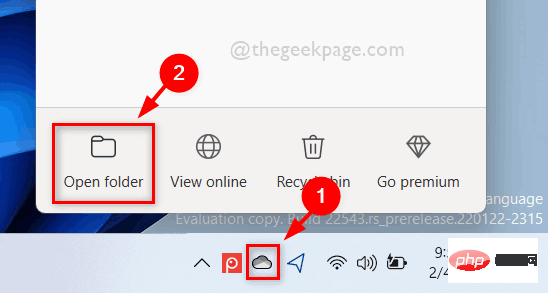With the development of the Internet, websites are becoming more and more complex, their functions are becoming more and more abundant, and users’ needs are becoming more and more diversified. In order to facilitate users to quickly locate the required functions, the navigation menu has become indispensable. element. How to use the navigation menu in ThinkPHP6? This article will introduce you step by step.
1. Create a navigation menu data table
In ThinkPHP6, we can use a database to store navigation menu information. First, we need to create a navigation menu data table. The specific table structure is as follows:
CREATE TABLE `menu` ( `id` bigint(20) UNSIGNED NOT NULL AUTO_INCREMENT, `title` varchar(255) NOT NULL COMMENT '菜单名称', `url` varchar(255) NOT NULL DEFAULT '' COMMENT '菜单链接地址', `parent_id` bigint(20) UNSIGNED NOT NULL COMMENT '父级菜单ID', `order` int(11) NOT NULL DEFAULT '0' COMMENT '排序', PRIMARY KEY (`id`) ) ENGINE=InnoDB DEFAULT CHARSET=utf8mb4 COMMENT='导航菜单表';
2. Import data
After creating the navigation menu data table, we need to import the navigation menu data into the database. Generally, we can import data in the following ways:
- Add data directly to the database manually
- Use command line tools to import data
- Writing scripts Batch import data
3. Create menu model
In ThinkPHP6, we can use the model to connect to the database and obtain the data in the database. Therefore, we need to create a menu model and define the table name, primary key, automatic timestamp and other attributes in the model. The specific code is as follows:
<?php
namespace appmodel;
use thinkModel;
class Menu extends Model
{
protected $table = 'menu';
protected $pk = 'id';
protected $autoWriteTimestamp = true;
}4. Create a menu controller
Menu control The processor is responsible for processing all logic related to the menu, including how to obtain menu data, how to render the menu view, etc. In ThinkPHP6, we can use command line tools to quickly generate controllers. The specific command is as follows:
php think make:controller Menu
After the command execution is completed, we can find the generated Menu.php file in the appcontroller directory. Then we can define a method to get the navigation menu in the controller. The specific code is as follows:
<?php
namespace appcontroller;
use appmodelMenu;
use think
acadeView;
class MenuController
{
public function index()
{
// 获取一级菜单
$menus = Menu::where('parent_id', 0)->order('order')->select();
// 获取当前选中的菜单ID
$selectedId = input('get.id', '');
View::assign([
'menus' => $menus,
'selectedId' => $selectedId,
]);
return View::fetch('index');
}
}In the controller, we use the where method of the Menu model To get the first-level menu, then assign the menu data and the currently selected menu ID to the view, and finally render the view.
5. Create a menu view
The menu view is used to display the navigation menu. We can display the navigation menu at the head or left side of the page. The specific location can be determined according to actual needs. In the view, we can use the foreach loop to traverse the menu data and then output the corresponding HTML code.
<nav>
<ul>
<?php foreach ($menus as $menu): ?>
<li class="<?php if ($selectedId == $menu['id']) echo 'active' ?>">
<a href="<?php echo $menu['url'] ?>"><?php echo $menu['title'] ?></a>
</li>
<?php endforeach; ?>
</ul>
</nav>6. Create a route
In ThinkPHP6, we need to create a route to access the index method of the menu controller. The specific code is as follows:
use think
acadeRoute;
Route::get('menu/index', 'MenuController@index');After the route is defined, we can access the menu page through http://localhost/menu/index.
Summary
The above is the complete process of using navigation menu in ThinkPHP6, including creating navigation menu data table, importing data, creating menu model, creating menu controller, creating menu view and creating routing. Through this example, I believe that everyone has mastered the skills of how to use the navigation menu in ThinkPHP6, and can quickly apply it in the project.
The above is the detailed content of How to use navigation menu in ThinkPHP6. For more information, please follow other related articles on the PHP Chinese website!
 如何在Go中使用命名管道?May 11, 2023 pm 04:22 PM
如何在Go中使用命名管道?May 11, 2023 pm 04:22 PM命名管道是一种在操作系统中相对比较低级的进程通信方式,它是一种以文件为中介的进程通信方式。在Go语言中,通过os包提供了对命名管道的支持。在本文中,我们将介绍如何在Go中使用命名管道来实现进程间通信。一、命名管道的概念命名管道是一种特殊的文件,可以被多个进程同时访问。在Linux系统中,命名管道是一种特殊的文件类型,它们存在于文件系统的某个位置上,并且可以在
 如何在Go中使用第三方库?May 11, 2023 pm 03:30 PM
如何在Go中使用第三方库?May 11, 2023 pm 03:30 PM在Go语言中,使用第三方库是非常方便的。许多优秀的第三方库和框架可以帮助我们快速地开发应用程序,同时也减少了我们自己编写代码的工作量。但是如何正确地使用第三方库,确保其稳定性和可靠性,是我们必须了解的一个问题。本文将从以下几个方面介绍如何使用第三方库,并结合具体例子进行讲解。一、第三方库的获取Go语言中获取第三方库有以下两种方式:1.使用goget命令首先
 如何在PHP中使用协程?May 12, 2023 am 08:10 AM
如何在PHP中使用协程?May 12, 2023 am 08:10 AM随着传统的多线程模型在高并发场景下的性能瓶颈,协程成为了PHP编程领域的热门话题。协程是一种轻量级的线程,能够在单线程中实现多任务的并发执行。在PHP的语言生态中,协程得到了广泛的应用,比如Swoole、Workerman等框架就提供了对协程的支持。那么,如何在PHP中使用协程呢?本文将介绍一些基本的使用方法以及常见的注意事项,帮助读者了解协程的运作原理,以
 如何在Go中使用音频处理?May 11, 2023 pm 04:37 PM
如何在Go中使用音频处理?May 11, 2023 pm 04:37 PM随着音频处理在各种应用场景中的普及,越来越多的程序员开始使用Go编写音频处理程序。Go语言作为一种现代化的编程语言,具有优秀的并发性和高效率的特点,使用它进行音频处理十分方便。本文将介绍如何在Go中使用音频处理技术,包括读取、写入、处理和分析音频数据等方面的内容。一、读取音频数据在Go中读取音频数据有多种方式。其中比较常用的是使用第三方库进行读取,比如go-
 如何在 Windows 11 中按需使用 OneDrive 的文件Apr 14, 2023 pm 12:34 PM
如何在 Windows 11 中按需使用 OneDrive 的文件Apr 14, 2023 pm 12:34 PM<p>Windows 系统上的 OneDrive 应用程序允许您将文件存储在高达 5 GB 的云上。OneDrive 应用程序中还有另一个功能,它允许用户选择一个选项,是将文件保留在系统空间上还是在线提供,而不占用您的系统存储空间。此功能称为按需文件。在这篇文章中,我们进一步探索了此功能,并解释了有关如何在 Windows 11 电脑上的 OneDrive 中按需使用文件的各种选项。</p><h2>如何使用 On
 如何在Go中使用WebSocket?May 11, 2023 pm 04:17 PM
如何在Go中使用WebSocket?May 11, 2023 pm 04:17 PM近年来,WebSocket技术已经成为了Web开发中不可或缺的一部分。WebSocket是一种在单个TCP连接上进行全双工通信的协议,它使得客户端和服务器之间的通信更加流畅和高效。如今,很多现代的Web应用程序都使用了WebSocket技术,例如实时聊天、在线游戏以及实时数据可视化等。Go语言作为一个现代的编程语言,自然也提供了很好的支持WebSock
 如何在Go中使用嵌套结构?May 11, 2023 pm 04:39 PM
如何在Go中使用嵌套结构?May 11, 2023 pm 04:39 PM在Go语言中,嵌套结构是一种非常常见的技术。通过将一个结构体嵌入到另一个结构体中,我们可以将复杂的数据模型分解成更小的部分,使其易于理解和维护。本篇文章将介绍如何在Go中使用嵌套结构以及一些最佳实践。一、定义嵌套结构首先,我们需要定义一个包含嵌套结构的结构体。下面的代码演示了如何定义一个包含Person结构体的Company结构体:typePersons
 如何在Go中使用反转依赖?May 11, 2023 pm 03:39 PM
如何在Go中使用反转依赖?May 11, 2023 pm 03:39 PMGo语言中的反转依赖是一种非常实用的技术,它可以帮助开发者更好地进行软件开发。在本文中,我们将详细介绍什么是反转依赖,并且演示如何在Go语言中使用它来优化软件。一、什么是反转依赖在传统的软件开发中,模块之间存在着依赖关系。一些模块被其他模块所依赖,而另一些模块则依赖于其他模块。这种依赖关系在软件中非常普遍,但同时也会带来很多问题。一旦一个模块的代码发生了变化


Hot AI Tools

Undresser.AI Undress
AI-powered app for creating realistic nude photos

AI Clothes Remover
Online AI tool for removing clothes from photos.

Undress AI Tool
Undress images for free

Clothoff.io
AI clothes remover

AI Hentai Generator
Generate AI Hentai for free.

Hot Article

Hot Tools

Dreamweaver Mac version
Visual web development tools

VSCode Windows 64-bit Download
A free and powerful IDE editor launched by Microsoft

MinGW - Minimalist GNU for Windows
This project is in the process of being migrated to osdn.net/projects/mingw, you can continue to follow us there. MinGW: A native Windows port of the GNU Compiler Collection (GCC), freely distributable import libraries and header files for building native Windows applications; includes extensions to the MSVC runtime to support C99 functionality. All MinGW software can run on 64-bit Windows platforms.

PhpStorm Mac version
The latest (2018.2.1) professional PHP integrated development tool

SAP NetWeaver Server Adapter for Eclipse
Integrate Eclipse with SAP NetWeaver application server.






